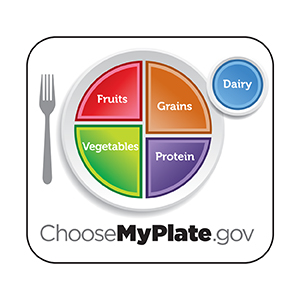Your calorie needs are about 1,600 calories a day. Below are the USDA guidelines for your daily recommended amount of each food group.
|
Vegetables 2 cups |
Fruits 1½ cups |
Grains 5 ounces |
Dairy 3 cups |
Protein 5 ounces |
|
Eat a variety of vegetables each day. Aim for these amounts each week:
|
Eat a variety of fruits each day. Go easy on fruit juices. Good choices of fruits include:
|
Choose whole grains whenever you can. Aim to eat at least 2½ ounces of whole grains each day:
|
Choose low-fat or fat-free milk, yogurt, or cheese each day. Good choices include:
|
Choose low-fat or lean meats, poultry, fish, and seafood each day. Vary your protein. Choose more:
Choose less high-fat and red meat. |
Source: USDA MyPlate, www.myplate.gov
Know your limits on sodium, saturated fat, and added sugars
-
Your allowance for saturated fat is 18 grams a day.
-
Limit the added sugars to 40 grams a day.
-
Cut back on salt (sodium). Stay under 2,300 mg sodium a day. If you have a health condition such as heart disease or high blood pressure, your doctor will likely tell you to limit sodium to no more than 1,500 mg a day.
Get moving and be active!
Aim for at least 30 minutes of physical activity most days of the week or 150 minutes of moderate exercise a week.
MyPlate servings worksheet: 1,600 calories
This worksheet tells you how many servings you should get each day from each food group, and tells you how much food makes a serving. Use this as a guide as you plan your meals throughout the day. Track your progress daily by writing in what you actually ate.
|
Food group |
Daily MyPlate goal |
What you ate today |
|
Vegetables |
4 half-cups or 4 servings One serving is: ½ cup cut-up raw or cooked vegetables 1 cup raw, leafy vegetables ½ baked sweet potato ½ cup vegetable juice Note: At meals, fill half your plate with vegetables and fruit and eat them first. |
|
|
Fruits |
3 half-cups or 3 servings One serving is: ½ cup fresh, frozen, or canned fruit 1 medium piece of fruit 1 cup of berries or melon ½ cup dried fruit ½ cup 100% fruit juice Note: Make most choices fruit instead of juice. |
|
|
Grains |
5 servings or 5 ounces One serving is: 1 slice bread 1 cup dry cereal ½ cup cooked rice, pasta, or cereal 1 5-inch tortilla Note: Choose whole grains for at least half of your servings each day. |
|
|
Dairy |
3 servings or 3 cups One serving is: 1 cup milk 1½ ounces reduced-fat hard cheese 2 ounces processed cheese 1 cup low-fat yogurt 1/3 cup shredded cheese Note: Choose low-fat or fat-free most often. |
|
|
Protein |
5 servings or 5 ounces One serving is: 1 ounce cooked lean beef, pork, lamb, or ham 1 ounce cooked chicken or turkey (no skin) 1 ounce cooked fish or shellfish (not fried) 1 egg ¼ cup egg substitute ½ ounce nuts or seeds 1 tablespoon peanut or almond butter ¼ cup cooked dry beans or peas ½ cup tofu 2 tablespoons hummus |


